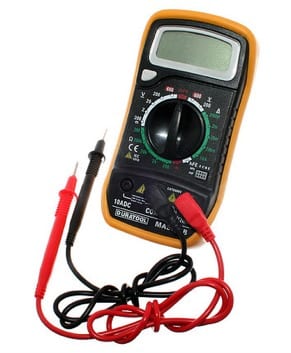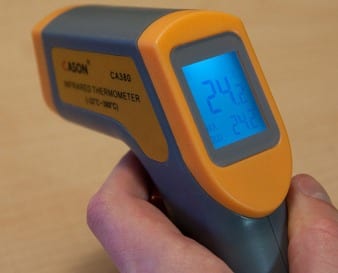Here is a quick low down on what HVAC test instruments you do and don’t need along with what features they do and don’t need to have. (Click here if you missed Part 1.)
 Number one on our list is the Digital Multimeter. This is the main staple of your test instruments; you use it multiple times every day. It lives in your tool bag along with wrenches, pliers, screwdrivers, you name it. It gets rained on, left out in the sun, dropped, and generally abused. It had better be a robust instrument considering you trust your life to it, literally. This is one item that you do not want to cheap out on. However, you still don’t need to pay for features you will never use.
Number one on our list is the Digital Multimeter. This is the main staple of your test instruments; you use it multiple times every day. It lives in your tool bag along with wrenches, pliers, screwdrivers, you name it. It gets rained on, left out in the sun, dropped, and generally abused. It had better be a robust instrument considering you trust your life to it, literally. This is one item that you do not want to cheap out on. However, you still don’t need to pay for features you will never use.
Features you NEED … Yes, every one of them!
- Digital display
- A/C and D/C volts, rated to 600 volts.
- Ohms
- Capacitance
- Milli-amps
- Hz
- Water resistant case
- Rugged case
- Accessory amp clamp
Very useful (but not necessary) features:
- Non-contact voltage tester
- Back-lit display
- Temperature probe
- Magnetic back
- Max-Hold feature
- Mega ohm feature
- Accessories that need to be available if not included.
- Amp Clamp
- Alligator style lead ends
- Fine point style lead ends
- High voltage probe
Features that are a waste of money for HVAC.
- True RMS
- Continuity tester
- Built in work light
- Bar Graph display
 Second on our list is a digital thermometer with remote temperature probes. This is another instrument that will see daily duty and more than its fair share of field abuse. It will need to be accurate, and the remote probes need to be robust enough to handle high temperatures, sharp metal edges, and repeated coiling and uncoiling. Thermocouple sensors (type K) generally react to temperature changes much faster than thermistor style and are usually more durable.
Second on our list is a digital thermometer with remote temperature probes. This is another instrument that will see daily duty and more than its fair share of field abuse. It will need to be accurate, and the remote probes need to be robust enough to handle high temperatures, sharp metal edges, and repeated coiling and uncoiling. Thermocouple sensors (type K) generally react to temperature changes much faster than thermistor style and are usually more durable.
Features you need:
- At least 2 temperature inputs
- 2 surface probes
- 1 insertion probe
- Min / Max recording
- Rugged case
- Water resistant case
Very useful (but not necessary) features:
- Type K Thermocouple sensors
- Back-lit display
- Probe temp Differential readout
- Real time data logging
- Humidity / Wet bulb probe
You can find Part 1 of this series here. Stay tuned for Part 3, where Patrick lists the other two must-have instruments for HVAC.


I’m a fan of the alligator-style lead ends. Personal preference?
Great call Steve!
It’s often the small items that make your life easier. Alligator leads are one of those items, and as a bonus, they make your job safer also. I also liked the small, spring loaded, hook style lead ends.
Looking back, I should have listed them as a must have.
Patrick
Before you can categorize features as needed of not needed you need to understand application. Before you can understand application you need to understand the end user. You also need to understand the acceptable uncertainty on the measurement. (a K-type is typically only +/- 4 degrees) Taking time with customers to understand their testing application is critical to selecting the correct instrument. While wet bulb may not be a necessary feature to you, for the fellow charging an air conditioner it is critical. A back lit display to a customer with aging eyes is a necessity. If you work on frequency drives True RMS is a must. While I do agree it is not wise to over buy or over sell, I disagree on many of the “Very useful (but not necessary) features” as without understanding of application you might be wrong. Many sales people make the mistake of selling features. A good sales person understands and sells applications. The main reason you may see the features as useless is you either do not need it for your application or the application of the feature has not been adequately explained to you.